Geographic Inequalities in Accessing Improved Water and Sanitation Facilities in Nepal
Abstract
1. Introduction
2. Methods
2.1. Study Setting
2.2. Outcome and Explanatory Measures
2.3. Data Analysis
2.4. Ethical Approval
3. Results
3.1. Descriptive Statistics
3.2. Multivariable Regression Analysis
4. Discussion
Strengths and Limitations
5. Conclusions
Author Contributions
Funding
Acknowledgments
Conflicts of Interest
References
- Cairncross, S.; Valdmanis, V. Water Supply, Sanitation, and Hygiene Promotion. In Disease Control Priorities in Developing Countries; Jamison, D.T., Breman, J.G., Measham, A.R., Alleyne, G., Claeson, M., Evans, D.B., Jha, P., Mills, A., Musgrove, P., Eds.; World Bank: Washington, DC, USA, 2006; ISBN 978-0-8213-6179-5. [Google Scholar]
- Cairncross, S.; Bartram, J.; Cumming, O.; Brocklehurst, C. Hygiene, sanitation, and water: what needs to be done? PLoS Med. 2010, 7, e1000365. [Google Scholar] [CrossRef] [PubMed]
- Yates, T.; Lantagne, D.; Mintz, E.; Quick, R. The impact of water, sanitation, and hygiene interventions on the health and well-being of people living with HIV: a systematic review. J. Acquir. Immune Defic. Syndr. 2015, 68 (Suppl. 3), S318–S330. [Google Scholar] [CrossRef] [PubMed]
- Hutton, G.; Chase, C. The Knowledge Base for Achieving the Sustainable Development Goal Targets on Water Supply, Sanitation and Hygiene. Int. J. Environ. Res. Public. Health 2016, 13, 536. [Google Scholar] [CrossRef] [PubMed]
- Taylor, D.L.; Kahawita, T.M.; Cairncross, S.; Ensink, J.H.J. The Impact of Water, Sanitation and Hygiene Interventions to Control Cholera: A Systematic Review. PLoS ONE 2015, 10, e0135676. [Google Scholar] [CrossRef] [PubMed]
- Rah, J.H.; Cronin, A.A.; Badgaiyan, B.; Aguayo, V.M.; Coates, S.; Ahmed, S. Household sanitation and personal hygiene practices are associated with child stunting in rural India: A cross-sectional analysis of surveys. BMJ Open 2015, 5, e005180. [Google Scholar] [CrossRef] [PubMed]
- Torlesse, H.; Cronin, A.A.; Sebayang, S.K.; Nandy, R. Determinants of stunting in Indonesian children: evidence from a cross-sectional survey indicate a prominent role for the water, sanitation and hygiene sector in stunting reduction. BMC Public Health 2016, 16, 669. [Google Scholar] [CrossRef]
- Dangour, A.D.; Watson, L.; Cumming, O.; Boisson, S.; Che, Y.; Velleman, Y.; Cavill, S.; Allen, E.; Uauy, R. Interventions to improve water quality and supply, sanitation and hygiene practices, and their effects on the nutritional status of children. Cochrane Database Syst. Rev. 2013, CD009382. [Google Scholar] [CrossRef]
- Shrestha, A.; Sharma, S.; Gerold, J.; Erismann, S.; Sagar, S.; Koju, R.; Schindler, C.; Odermatt, P.; Utzinger, J.; Cissé, G. Water Quality, Sanitation, and Hygiene Conditions in Schools and Households in Dolakha and Ramechhap Districts, Nepal: Results from A Cross-Sectional Survey. Int. J. Environ. Res. Public. Health 2017, 14, 89. [Google Scholar] [CrossRef] [PubMed]
- Karkey, A.; Jombart, T.; Walker, A.W.; Thompson, C.N.; Torres, A.; Dongol, S.; Tran Vu Thieu, N.; Pham Thanh, D.; Tran Thi Ngoc, D.; Voong Vinh, P.; et al. The Ecological Dynamics of Fecal Contamination and Salmonella Typhi and Salmonella Paratyphi A in Municipal Kathmandu Drinking Water. PLoS Negl. Trop. Dis. 2016, 10, e0004346. [Google Scholar] [CrossRef] [PubMed]
- Wardrop, N.A.; Hill, A.G.; Dzodzomenyo, M.; Aryeetey, G.; Wright, J.A. Livestock ownership and microbial contamination of drinking-water: Evidence from nationally representative household surveys in Ghana, Nepal and Bangladesh. Int. J. Hyg. Environ. Health 2018, 221, 33–40. [Google Scholar] [CrossRef]
- Adane, M.; Mengistie, B.; Kloos, H.; Medhin, G.; Mulat, W. Sanitation facilities, hygienic conditions, and prevalence of acute diarrhea among under-five children in slums of Addis Ababa, Ethiopia: Baseline survey of a longitudinal study. PLoS ONE 2017, 12, e0182783. [Google Scholar] [CrossRef] [PubMed]
- Kumar, G.S.; Kar, S.S.; Jain, A. Health and environmental sanitation in India: Issues for prioritizing control strategies. Indian J. Occup. Environ. Med. 2011, 15, 93–96. [Google Scholar] [CrossRef] [PubMed]
- Thakur, J.K.; Thakur, R.K.; Ramanathan, A.L.; Kumar, M.; Singh, S.K. Arsenic Contamination of Groundwater in Nepal—An Overview. Water 2010, 3, 1–20. [Google Scholar] [CrossRef]
- Pokhrel, D.; Bhandari, B.S.; Viraraghavan, T. Arsenic contamination of groundwater in the Terai region of Nepal: An overview of health concerns and treatment options. Environ. Int. 2009, 35, 157–161. [Google Scholar] [CrossRef] [PubMed]
- Marahatta, S.B. Control of the Outbreak of Disease Aftermath Earthquake: An Overview. Nepal J. Epidemiol. 2015, 5, 468–469. [Google Scholar] [CrossRef] [PubMed]
- Adhikari, B.; Mishra, S.R.; Raut, S. Rebuilding Earthquake Struck Nepal through Community Engagement. Front. Public Health 2016, 4, 121. [Google Scholar] [CrossRef] [PubMed]
- Water in Crisis—Spotlight Nepal. Available online: https://thewaterproject.org/water-crisis/water-in-crisis-nepal (accessed on 18 February 2018).
- Goli, S.; Bhandari, P.; Atla, U.M.R.; Chattopadhayay, A. Childhood Mortality Differentials by Ecological Region in Nepal. Popul. Space Place 2017, 23, e1977. [Google Scholar] [CrossRef]
- WHO/UNICEF Joint Monitoring Programme for Water Supply and Sanitation. 2010. Available online: https://www.who.int/water_sanitation_health/publications/9789241563956/en/ (accessed on 9 April 2019).
- An Overview of the Far Western Region of Nepal | UN Nepal Information Platform. Available online: http://un.org.np/node/14662 (accessed on 19 February 2018).
- Bhandari, G.P.; Bhusal, C.L. Cholera outbreak in far-western region of Nepal. J. Nepal Health Res. Counc. 2013, 11, 6–8. [Google Scholar]
- UNICEF—WASH. Available online: http://unicef.org.np/our-work/WASH (accessed on 19 February 2018).
- Pullan, R.L.; Freeman, M.C.; Gething, P.W.; Brooker, S.J. Geographical Inequalities in Use of Improved Drinking Water Supply and Sanitation across Sub-Saharan Africa: Mapping and Spatial Analysis of Cross-sectional Survey Data. PLoS Med. 2014, 11, e1001626. [Google Scholar] [CrossRef] [PubMed]
- Yu, W.; Bain, R.E.; Mansour, S.; Wright, J.A. A cross-sectional ecological study of spatial scale and geographic inequality in access to drinking-water and sanitation. Int. J. Equity Health 2014, 13, 113. [Google Scholar] [CrossRef]
- Acharya, A.; Liu, L.; Li, Q.; Friberg, I.K. Estimating the child health equity potential of improved sanitation in Nepal. BMC Public Health 2013, 13, S25. [Google Scholar]
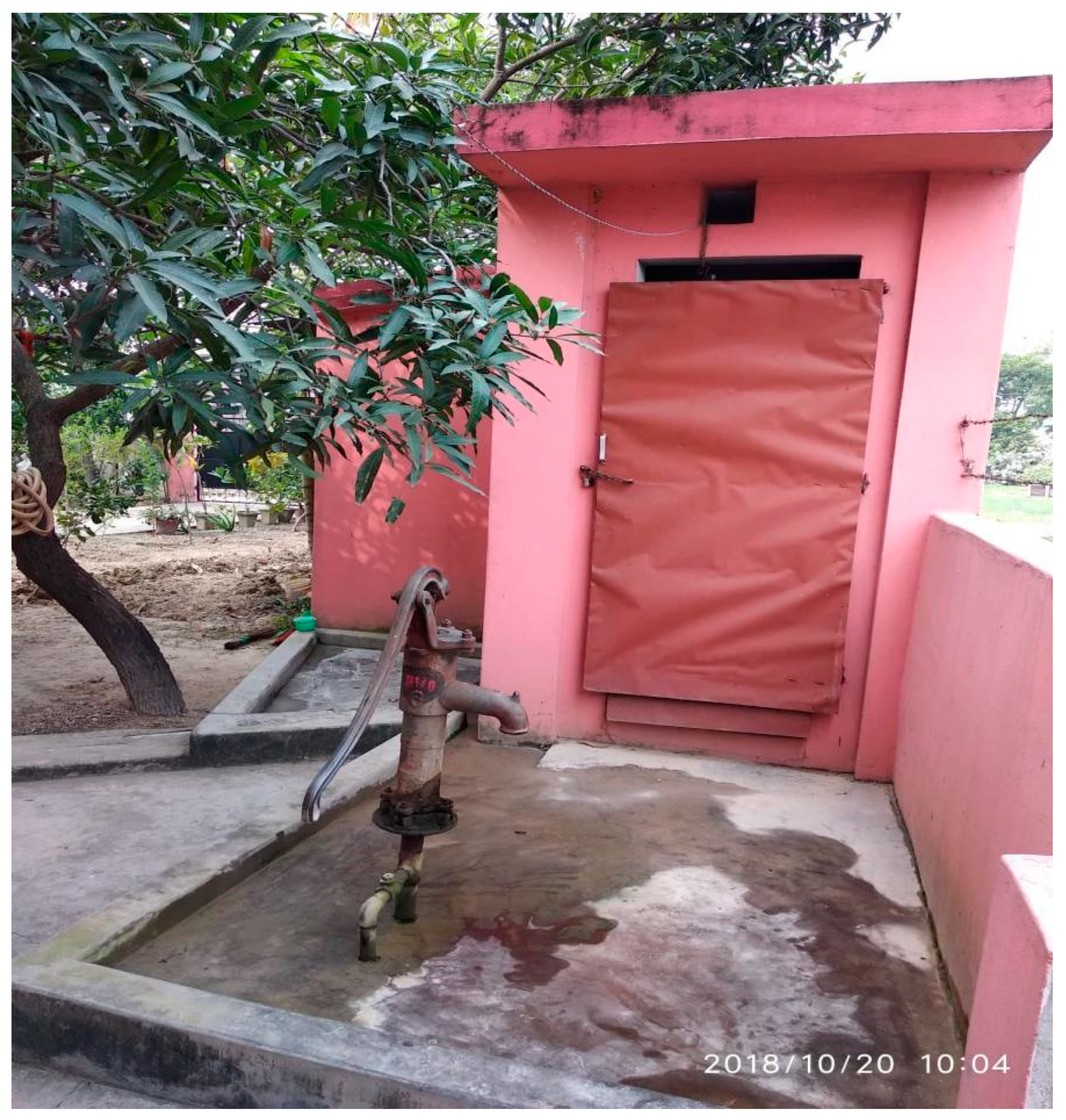
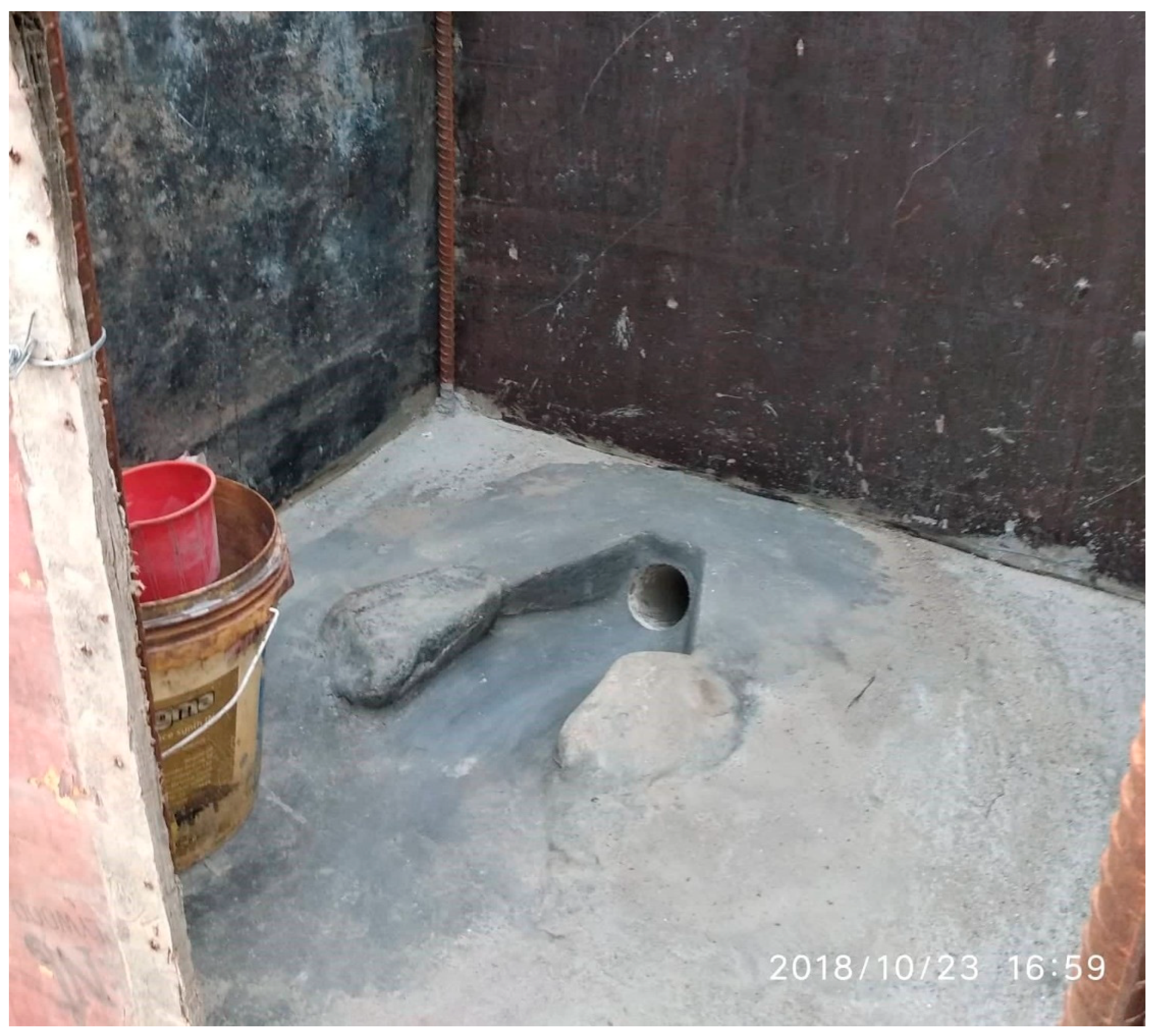
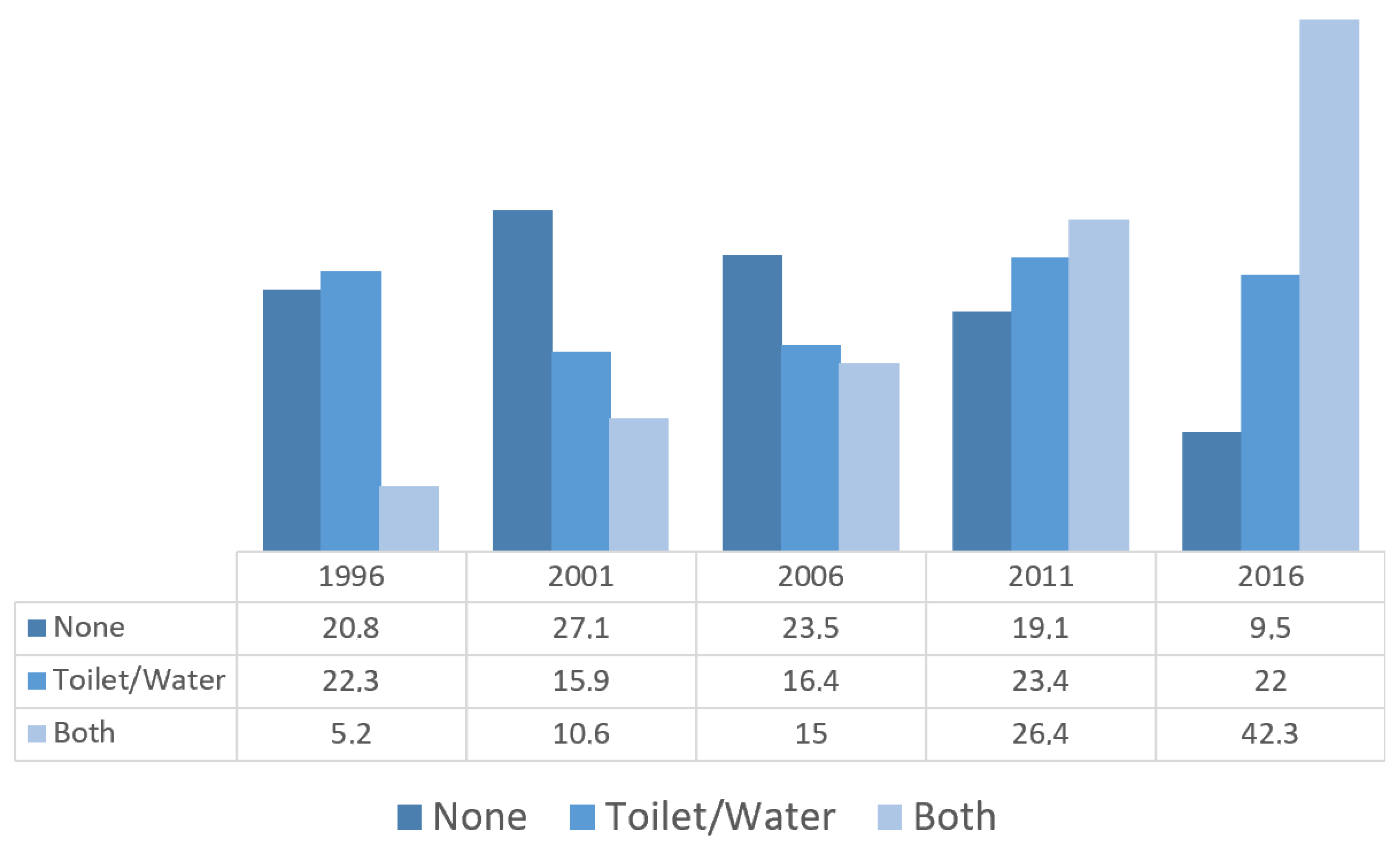
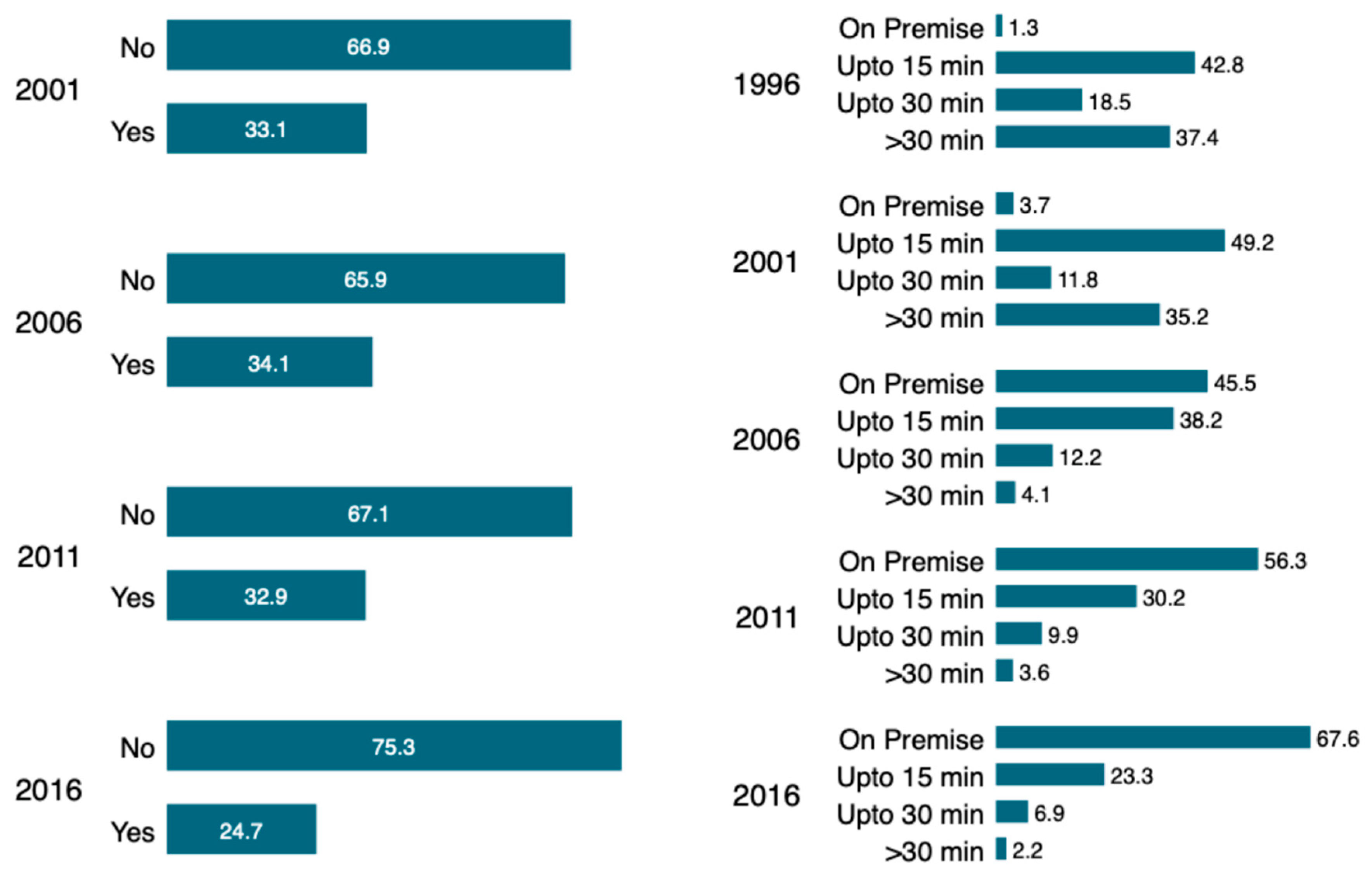
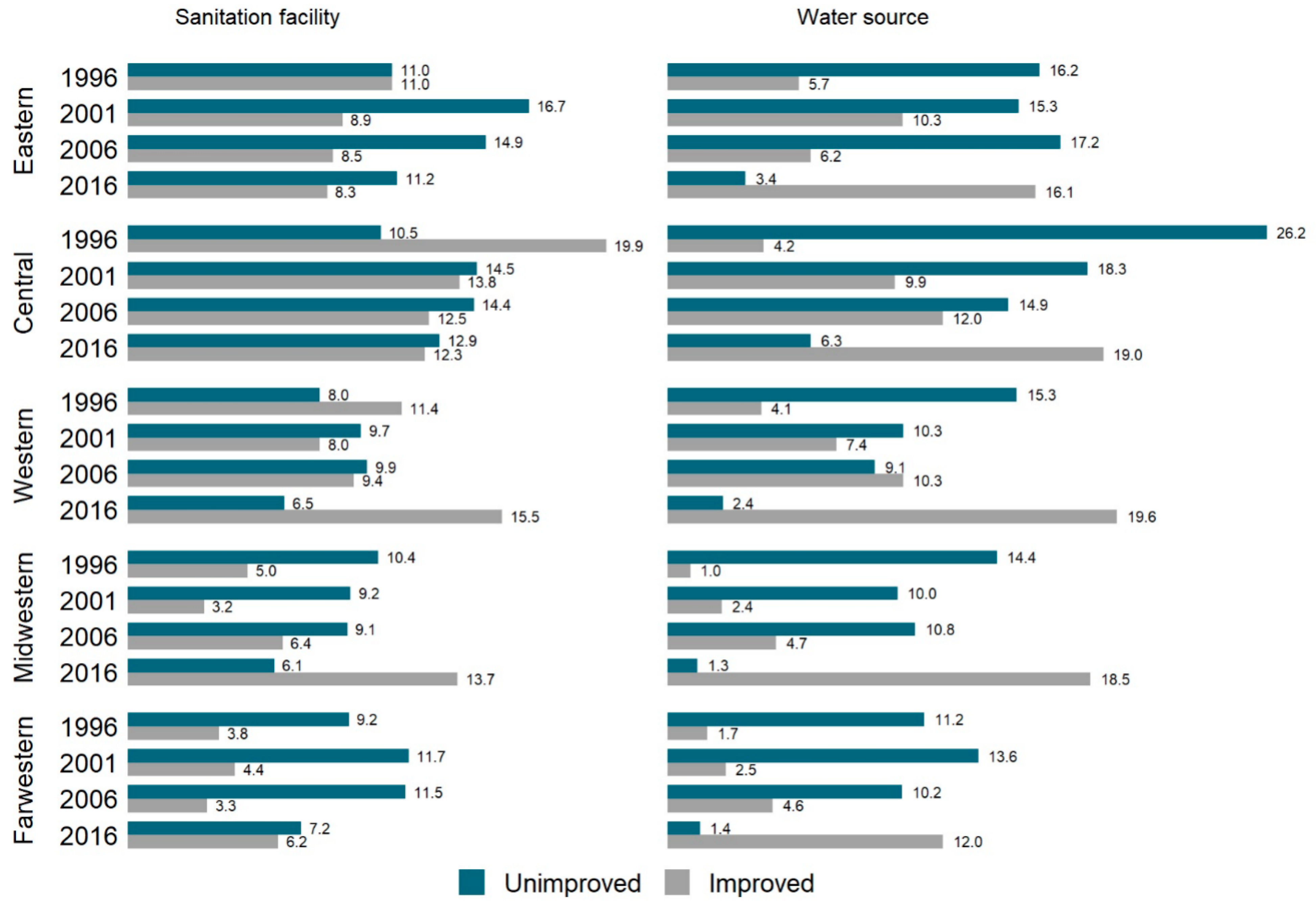

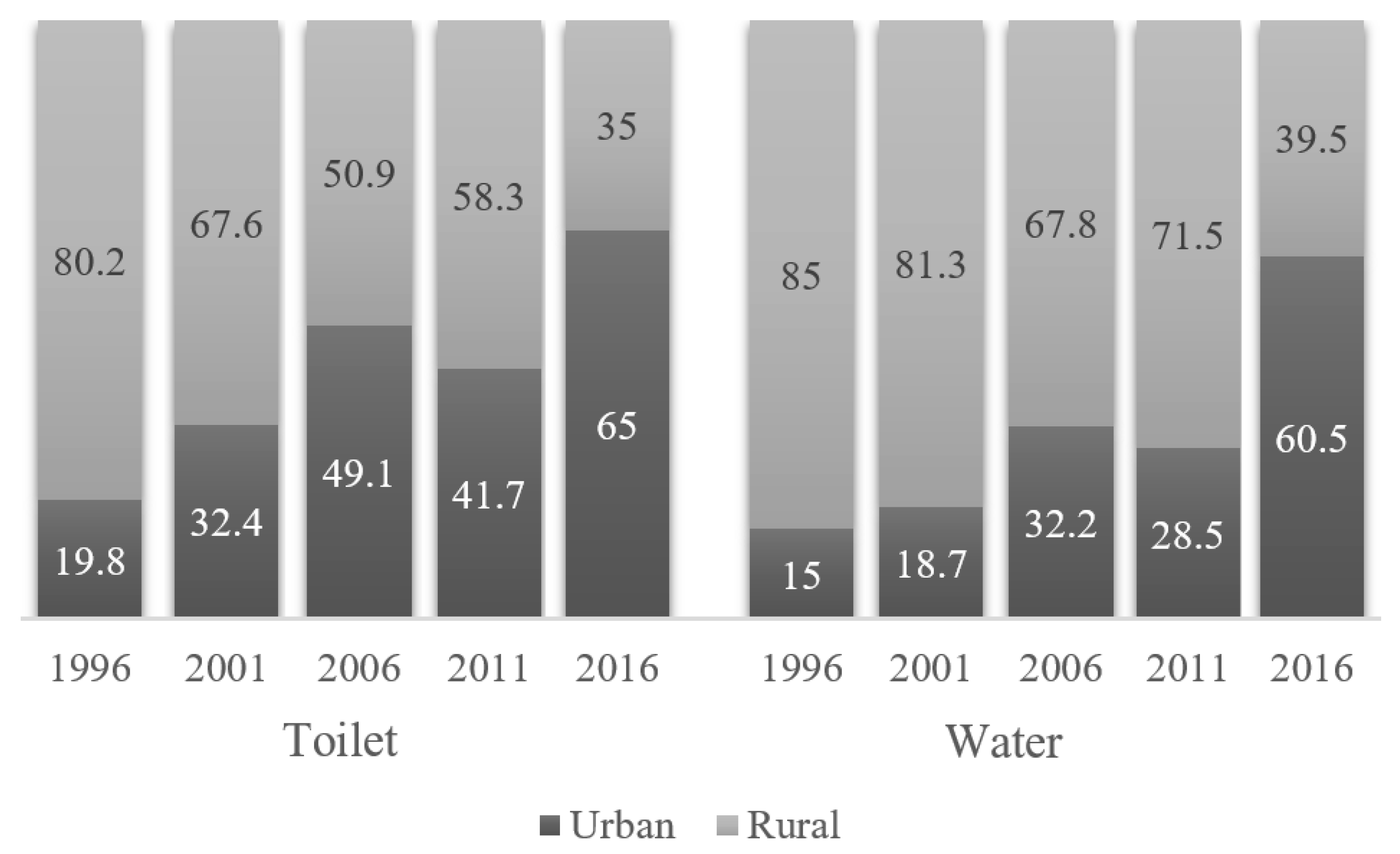
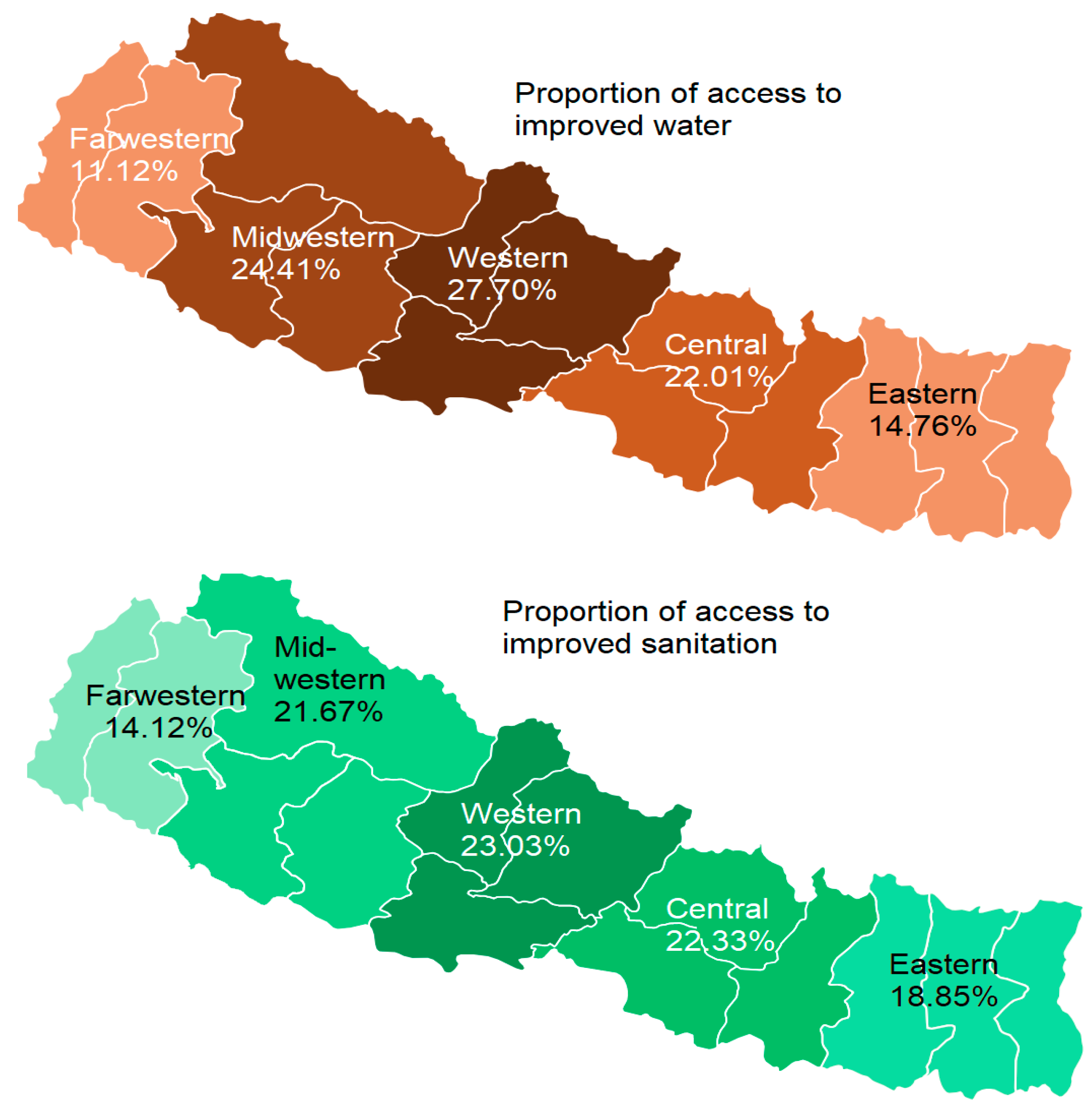
| Type of Facility | Unimproved | Improved |
|---|---|---|
| Sanitation | Unimproved sanitation facilities: do not ensure hygienic separation of human excreta from human contact. Unimproved facilities include pit latrines without a slab or platform, hanging latrines and bucket latrines. | Improved sanitation facilities: ensure hygienic separation of human excreta from human contact. They are use of the following facilities: Flush/pour flush to: piped sewer system, septic tank, pit latrine; Ventilated improved pit (VIP) latrine, Pit latrine with slab, Composting toilet. |
| Water | unimproved drinking-water sources: Unprotected dug well, unprotected spring, cart with small tank/drum, surface water (river, dam, lake, pond, stream, canal, irrigation channels), and bottled water. | Other improved drinking-water sources: Public taps or standpipes, tube wells or boreholes, protected dug wells, protected springs or rainwater collection. Piped water on premises: Piped household water connection located inside the user’s dwelling, plot or yard. |
| Variables | Definitions | (N = 47,257) (%) | Access to Improved Sanitation 47.7% (95% CI = 45.8–49.6) | Access to Improved Water 46.0% (95% CI = 43.7–48.3) |
|---|---|---|---|---|
| Year | ||||
| 1996 | Year of conducting the field work | 8082, 17.1 | 5.6 (4.7, 6.6) | 19.3 (17.7, 20.9) |
| 2001 | 8602, 18.2 | 11.6 (10.5, 12.9) | 14.0 (12.4, 15.8) | |
| 2006 | 8707, 18.4 | 14.9 (12.9, 17.1) | 16.4 (14.1, 19.0) | |
| 2011 | 10,826, 22.9 | 27.4 (24.4, 30.6) | 23.3 (20.6, 26.3) | |
| 2016 | 11,040, 23.4 | 40.5 (37.4, 43.7) | 27.0 (24.3, 29.9) | |
| p-value | <0.001 | <0.001 | ||
| Developmental region | ||||
| Eastern | Divisions based on administrative goals and state of socioeconomic development | 10,063, 21.3 | 18.6 (16.4, 21.0) | 17.9 (15.7, 20.3) |
| Central | 14,412, 30.5 | 36.8 (33.8, 40.0) | 42.7 (39.6, 45.8) | |
| Western | 11,731, 24.8 | 31.0 (28.1, 34.0) | 25.3 (22.5, 28.2) | |
| Midwestern | 5847, 12.4 | 8.1 (6.7, 9.7) | 9.2 (7.6, 11.1) | |
| Far-western | 5204, 11 | 5.5 (4.7, 6.3) | 4.9 (4.2, 5.8) | |
| p-value | <0.001 | <0.001 | ||
| Ecological zone * | ||||
| Mountain | Divisions based on biogeographical and climactic patterns | 5450, 13.9 | 6.8 (5.5, 8.3) | 12.6 (10.8, 14.7) |
| Hill | 16,748, 42.8 | 52.1 (48.6, 55.5) | 68.5 (64.8, 71.9) | |
| Terai | 16,977, 43.3 | 41.2 (37.8, 44.6) | 18.9 (15.8, 22.4) | |
| p-value | <0.001 | <0.001 | ||
| Urbanicity | ||||
| Urban | Whether the household if located in rural or urban site | 14,721, 31.2 | 41.5 (38.7, 44.4) | 38.4 (35.5, 41.5) |
| Rural | 32,536, 68.8 | 58.5 (55.6, 61.3) | 61.6 (58.5, 74.5) | |
| p-value | 0.230 | <0.001 | ||
| Wealth index * | ||||
| Poorest | Index of relative wealth status of households based on the possession of durable goods (e.g., refrigerator and TV) and building material (e.g., concrete and wooden), rather than personal income | 6970, 22.8 | 11.6 (10.1, 13.3) | 23.5 (21.1, 26.0) |
| Poorer | 6070, 19.9 | 13.2 (12.0, 14.6) | 19.6 (18.0, 21.4) | |
| Middle | 5381, 17.6 | 15.4 (14.2, 16.7) | 15.0 (13.5, 16.6) | |
| Richer | 5822, 19 | 25.2 (23.5, 27.0) | 17.4 (15.5, 19.5) | |
| Richest | 6330, 20.7 | 34.6 (32.0, 37.4) | 24.5 (21.5, 27.8) | |
| p-value | <0.001 | <0.001 | ||
| Age | ||||
| <30 | Respondent’s age in completed year at the time of the survey | 7912, 16.7 | 16.1 (15.2, 17.0) | 17.1 (16.2, 17.9) |
| 30–39 | 11,606, 24.6 | 23.7 (23.0, 24.5) | 23.4 (22.7, 24.1) | |
| 40–49 | 10,478, 22.2 | 21.9 (21.3, 22.6) | 22.0 (21.4, 22.6) | |
| 50–59 | 8634, 18.3 | 18.9 (18.2, 19.6) | 18.3 (17.7, 18.9) | |
| 59+ | 8627, 18.3 | 19.3 (18.6, 20.1) | 19.2 (18.5, 20.0) | |
| p-value | <0.001 | <0.001 | ||
| Sex | ||||
| Male | Sex of the respondent | 36,217, 76.6 | 73.4 (72.4, 74.3) | 74.9 (74.0, 75.8) |
| Female | 11,040, 23.4 | 26.6 (25.7, 27.6) | 25.1 (24.2, 26.0) | |
| p-value | <0.001 | <0.001 | ||
| Education | ||||
| No education | Highest educational level obtained by the respondents categorised in terms of number of schooling years | 22,590, 47.8 | 34.3 (33.1, 35.6) | 44.1 (42.7, 45.5) |
| Primary | 10,468, 22.1 | 21.8 (21.0, 22.6) | 23.0 (22.3, 23.8) | |
| Secondary/higher | 10,500, 22.2 | 43.9 (42.4, 45.3) | 32.9 (31.4, 34.4) | |
| p-value | <0.001 | <0.001 | ||
| Region | Access to Improved Sanitation | Access to Improved Water | ||||||
|---|---|---|---|---|---|---|---|---|
| Sig. | OR | 95% CI | Sig. | OR | 95% CI | |||
| Lower | Upper | Lower | Upper | |||||
| Region (Eastern) | ||||||||
| Central | 0.559 | 0.970 | 0.874 | 1.075 | 0.077 | 0.923 | 0.845 | 1.009 |
| Western | <0.001 | 2.046 | 1.827 | 2.292 | <0.001 | 1.780 | 1.623 | 1.953 |
| Midwestern | <0.001 | 3.346 | 2.920 | 3.833 | <0.001 | 1.364 | 1.224 | 1.520 |
| Far-western | <0.001 | 3.062 | 2.655 | 3.532 | <0.001 | 0.600 | 0.535 | 0.673 |
| Ecological zone (Mountain) | ||||||||
| Hill | 0.860 | 0.990 | 0.886 | 1.106 | <0.001 | 0.457 | 0.415 | 0.503 |
| Terai | <0.001 | 0.230 | 0.115 | 0.446 | <0.001 | 0.234 | 0.131 | 0.337 |
| Urbanicity (Urban) | ||||||||
| Rural | <0.001 | 0.738 | 0.679 | 0.801 | 0.116 | 0.948 | 0.887 | 1.013 |
| Nagelkerke R2 | 0.618 | 0.575 | ||||||
© 2019 by the authors. Licensee MDPI, Basel, Switzerland. This article is an open access article distributed under the terms and conditions of the Creative Commons Attribution (CC BY) license (http://creativecommons.org/licenses/by/4.0/).
Share and Cite
Wang, C.; Pan, J.; Yaya, S.; Yadav, R.B.; Yao, D. Geographic Inequalities in Accessing Improved Water and Sanitation Facilities in Nepal. Int. J. Environ. Res. Public Health 2019, 16, 1269. https://doi.org/10.3390/ijerph16071269
Wang C, Pan J, Yaya S, Yadav RB, Yao D. Geographic Inequalities in Accessing Improved Water and Sanitation Facilities in Nepal. International Journal of Environmental Research and Public Health. 2019; 16(7):1269. https://doi.org/10.3390/ijerph16071269
Chicago/Turabian StyleWang, Chao, Jing Pan, Sanni Yaya, Ram Bilash Yadav, and Dechao Yao. 2019. "Geographic Inequalities in Accessing Improved Water and Sanitation Facilities in Nepal" International Journal of Environmental Research and Public Health 16, no. 7: 1269. https://doi.org/10.3390/ijerph16071269
APA StyleWang, C., Pan, J., Yaya, S., Yadav, R. B., & Yao, D. (2019). Geographic Inequalities in Accessing Improved Water and Sanitation Facilities in Nepal. International Journal of Environmental Research and Public Health, 16(7), 1269. https://doi.org/10.3390/ijerph16071269





